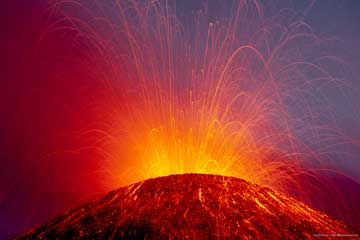|
NEWS NOTES — NEWS
Geophysics
Lava cooks up carbon nanotubes
 |
| New research suggests that lava from volcanoes such as Mount Etna, pictured here, may contain carbon nanotubes. Tom Pfeiffer/www.volcanodiscovery.com. |
Mount Etna may be a fiery factory for one of the most sought-after tools of nanotechnology: tiny carbon nanotubes. Etna’s lava contains all the necessary ingredients to construct the useful but difficult-to-make structures — and putting the lavas to work could streamline nanotube production, a team of researchers says.
Carbon nanotubes are tiny rolled-up sheets of graphite that form cylinders only a few nanometers across and up to several millimeters long. Although nanometer-sized carbon structures have been noted in scientific literature as early as the 1950s, carbon nanotubes achieved widespread fame in 1991, when images of the tiny tubes were taken with high-resolution transmission electron microscopy.
Part of the nanotubes’ fame is due to their unique properties: Although tiny, they can be extraordinarily strong, can conduct heat and can be designed to be either electrical conductors, semiconductors or insulators — properties that vary depending on the width, length and twist of the cylinders. The structures can also be either multi-walled, with several sheets of graphite rolled up together, or single-walled. The single-walled variety holds particular promise for microelectronics, as they can act like miniature conducting wires.
Although they are potentially extraordinarily useful, the practical problem is that carbon nanotubes are difficult to make, says Dang Sheng Su, a physicist at the Fritz Haber Institute of the Max Planck Society in Berlin, Germany. Researchers currently use a “catalytic synthesis method” to make the nanotubes. In that process, a carbon-containing gas, such as ethylene, surrounds a catalyst made out of tiny particles of metal, such as iron, copper or nickel, mounted in a silicon- or aluminum-based support. The particles catalyze the breakdown of the gas molecules into carbon, and from them a carbon nanotube begins to grow. The process requires very high temperatures — from 700 to 800 degrees Celsius — and involves the use of a chemical treatment to create the catalysts on their support.
Nature may already have a solution to these problems, however, in the form of lavas flowing down the flanks of Mount Etna in Sicily, Italy, Su says. Etna’s alkaline lava already contains all the necessary ingredients for nanotube production: carbon sources, in the form of gases; catalysts, in the form of already tiny particles of iron, copper, nickel and other metal oxides; and, of course, high temperatures. Most importantly, “the ingredients must be porous,” giving the gases access to the metal particles, Su says.
To test how well the lava worked, Su and colleague Xiao-Wei Chen set out to manufacture carbon nanotubes inside a reactor at high temperatures, using the metal oxides in powdered lava as a catalyst. The lava did its job: after reducing the oxides to metallic iron and then sending a mixture of ethylene and hydrogen gas over them, the researchers were able to grow carbon nanotubes on the surface of the lava. That process sidestepped the need for a “wet-chemical” treatment to affix the metal particles to their support, the team reported March 5 in Angewandte Chemie.
Eliminating the wet-chemical treatment makes the process more environmentally friendly, Su says. Further-more, the lava-based process generates a relative abundance of nanotubes, compared with other catalyst-free attempts at nanotube manufacture, he says: From one gram of powdered lava, he says, the researchers could produce 4 to 5 grams of carbon nanotubes.
The size of the iron oxide particles was one key to success, as they are already nanometer-sized, Su says. “Nano is fashionable, but it is not new — there must be many nano-sized materials in nature,” he says. That could also mean that carbon nanotubes could exist in nature, rather than as products of a lab, he says. “What we need is a carbon source, metal particles and high temperatures — all three conditions are fulfilled at a volcanic eruption.”
Whether the lava can eventually produce high yields of carbon nanotubes is not clear from the study, however, says Zhifeng Ren, a physicist at Boston College. The fibers that Su and colleagues produced were generally much too large to be considered true carbon nanotubes or nanofibers, Ren says. Materials that are too big do not show the same quantum effects as actual nanotubes. Additionally, he says, the study needs more data on how many real nanotubes could be produced per mass of lava before the method could be considered a real step forward.
Links:
Volcano Discovery Tours

 Subscribe
Subscribe


